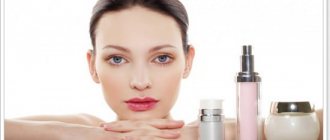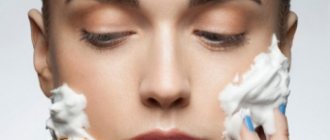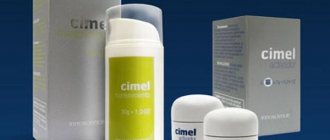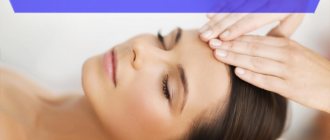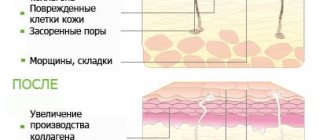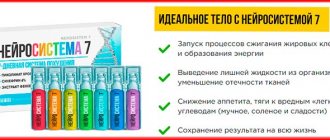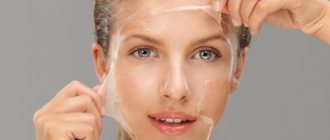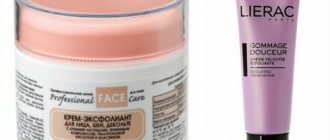General information about salon facial peeling
Facial peeling is a technique for cleansing and rejuvenation. Using special compounds and devices, a professional removes dead skin layers. At home, many girls independently carry out a superficial type of cleansing of the dermis. There are many drugs that allow you to conduct a session yourself, they include:
- essential oils;
- fruit and glycolic acids;
- abrasive particles.
At home, only superficial exfoliation is available. The salon session allows for medium or deep cleaning, depending on the patient's indications. Only the salon option quickly solves serious aesthetic problems and significantly rejuvenates the face.
Advantages and disadvantages of the procedure performed in the salon
There are a number of fundamental differences between the salon and home methods. The advantages of a salon include:
- high efficiency of the procedure;
- safety;
- the opportunity to solve serious aesthetic and physiological problems;
- spending a minimum amount of time; in some cases, one session is enough.
The main disadvantage was the high cost of transformation by professionals. To obtain and consolidate results, in most cases, it is necessary to undergo a course of procedures. The price of individual ones exceeds 20,000 rubles.
Only a professional can choose the best type of peeling based on the features and characteristics of a particular skin type.
Compositions for blackheads and acne
Peeling with aspirin for problem skin has its own specifics. You need to use it regularly. Cooking will not take much time. You will need 2 tablets of acetylsalicylic acid, which must be dissolved in a few drops of water. The consistency should be thick so that the mask does not run down the skin.
If there are a lot of pimples, then the mixture should be applied carefully, trying not to accidentally pick off the inflamed area. Aspirin should be left on the face for 10 minutes. After the first application, the areas of rashes will be reduced. This is due to the active anti-inflammatory effect of acetylsalicylic acid on acne.
If there are no acne, but there are blackheads, then during the procedure, the face can be massaged in places where comedones are especially concentrated. The result will be clean pores and a healthy complexion. Also read: Does peeling help with acne?
Video peeling for blackheads on the face:
The main rule when dealing with problematic epidermis is not to pick off purulent acne, otherwise you can only worsen the problem.
You can make a peeling composition based on olive oil, zinc ointment and chloramphenicol. This will require all the ingredients that need to be mixed in equal proportions. The tablets must first be thoroughly crushed. The finished product is applied for 10 minutes. Every 2 minutes it is recommended to massage the skin with your fingers or use a special sponge.
More information about peeling with aspirin at home can be read here.
Types of salon peelings according to the method of effect on the skin
Peeling is classified according to the method of exposure:
- Chemical. Biologically active components work.
- Mechanical.
- Enzymatic or biological. It is based on the action of enzymes, minerals or lactobacilli.
- Physical. The work takes place on devices using physical factors: ultrasound, laser, cold.
Let's look at the distinctive features and characteristics of each.
Mechanical
The technique is based on mechanical treatment of the selected area; during the session, one to several layers of the epidermis are removed. There are a number of types of exfoliation, depending on the strength of the effect on the skin:
- Light or brossage - affected depth up to 50 µm, only stratum corneum. The cosmetologist combines massage and cleansing. For the session, natural bristle brushes, scrubs and special emulsions are used. The best results are achieved by a course of 5-10 procedures. This gentle procedure is recommended for young people with problem skin. The result is cleansing of pores, evening out color and texture, improved blood circulation, and increased elasticity.
- Gommage - the effect is achieved due to the action of fruit acids; no hard abrasive particles are used. The procedure is suitable even for those with dry and sensitive skin. The gentle action of a professional mask, cream or gel will cleanse pores, improve the color and texture of the face, rejuvenate and heal the skin.
- Microdermabrasion - removal of dead cells, depth of effect up to 120 microns. The procedure requires special equipment, thanks to which micro-grinding occurs with small abrasive particles - aluminum dioxide crystals or diamond dust. Recommended for eliminating the effects of acne, scars, and first wrinkles. The technique is suitable for women suffering from allergic reactions to acids and is an alternative to chemical peeling.
Chemical
Chemical peeling for facial skin is a controlled burn of the dermis. The depth of effect is related to the concentration of the active substance. As a result, dead cells are removed, cleansed and rejuvenated. Divided into types according to the strength of impact:
- Surface. The mildest, using hydroxy acids and alpha hydroxyl acids. Recommended for people under 30 years old, solves acne and post-acne problems.
- Median. It is a sensitive procedure affecting living cells. A number of acids are used: trichloroacetic and salicylic. Helps eliminate age spots and the first signs of aging, whitens the skin.
- Deep. Aggressive technique using phenol. Recommended for patients over 55 years of age.
Peeling with fruit acids
Refers to the superficial type of chemical peeling. There are 6 types of acids as active substances:
- dairy;
- grape;
- glycolic;
- apple;
- lemon;
- wine
Suitable for solving problems of young skin and eliminating the first wrinkles.
Enzymatic or enzymatic
Based on the depth of impact, it is considered a superficial type of exfoliation. It is based on the work of enzymes of plant, animal or bacterial origin. Recommended for young skin, to solve problems of excessive sebaceous glands, healing and rejuvenation.
Enzyme peeling is suitable for people with sensitive skin and can be performed at any time of the year.
Mesopeeling
The technique appeared in 2000 and combined chemical exfoliation with an injection method of rejuvenation. During the procedure, a 1% acid solution is injected under the skin to a depth of 1 to 2 mm. Mesopeeling is more focused on eliminating existing defects than on cleaning.
The procedure can be performed on people of different age categories to solve aesthetic and physiological problems and preventive measures.
Ultrasonic
One of the easiest and most painless types of exfoliation. The work is based on the action of a sound wave. It has an effect at a frequency that is not perceptible to human hearing. The method has found wide application in cosmetology and medicine. If indicated, it can be performed on young and mature skin.
Laser
One of the safest methods to combat skin imperfections. To solve problems, a laser beam is used to evaporate the surface layers of cells from the selected area. Two types of laser are used for work: carbon and erbium. The first is distinguished by the possibility of scarring, the second acts more gently. The technique is aimed at different age categories, starting from a very young age.
Skin care after carbon peeling procedure
The skin does not require special care after carbon peeling. It may only develop slight redness, which will disappear completely after some time (usually 1-2 days). Given this fact, it is best to make an appointment the day before the weekend. By the time you need to go back to work, all the changes on your skin will have passed. By the way, it should be noted that in addition to redness, peeling may begin. However, do not worry, it also passes very quickly. To ensure that possible complications go away as quickly as possible, it is recommended to use a moisturizer with panthenol.
IMPORTANT:
After carbon peeling, it is advisable to avoid visiting beaches and solariums (ultraviolet rays may cause pigmentation to form on the skin again). The period of abstinence is usually 2-3 weeks.
It is not advisable to visit baths and saunas during the first 3 days after peeling.
Stages of facial peeling in a beauty salon
Each salon has its own distinctive stages of exfoliation. The procedure diagram everywhere consists of the following steps:
- Steaming.
- Application of the drug.
- Providing anesthesia if necessary.
- Use of special equipment in case of hardware type of peeling.
- Removal of applied drug residues.
- Treatment with an anesthetic or sedative.
- In case of deep impact , apply a bandage or a restorative mask.
- Compliance with the rules of the rehabilitation period.
An example of a session is presented in video materials from many beauty salons.
When is the best time to do a facial peel?
Traditionally, the best period is the autumn and winter seasons. At this time of year, ultraviolet activity is minimal.
Reviews from real people about facial peeling from cosmetologists
Anna, 25 years old:
From a young age I suffer from acne and acne. I tried different treatment options: acid and almond peels did not help. For dry, sensitive skin, the cosmetologist advised a course of procedure - gommage. Finally managed to solve all the problems. I recommend!
Olga, 31 years old:
For girls with facial skin problems after the age of 25, I advise you to try the hyaluranium method. The effect is noticeable immediately, the procedure does not cause discomfort. In the salon, to consolidate the result, 5 sessions were carried out. It was possible to whiten my face, remove freckles and the effects of acne. Thanks to the specialists!
Antonina, 57 years old:
Good day. After 50 years, age-related changes began to be noticeable on the skin, and even professional creams could not cope with the problems. Thanks to deep chemical peeling and the work of specialists, it was possible to significantly rejuvenate the face.
Natalya Podolskaya, 30 years old
I recommend that all girls with skin aging problems sign up for a needle peeling session. The cosmetologist’s work lasts no more than 30 minutes; after a couple of days, the face looks several years younger. I’m happy with the result, I didn’t find any cons for myself!
WHAT IS BODY PEELING
To get an idea of what body peeling is, you need to know how our skin, the largest human organ, works. The bottom line is that the top layer of integument - the epidermis - periodically dies, and the outdated horn cells exfoliate once a month.
Due to age and poor environmental conditions, natural exfoliation slows down, making it difficult for nutrients to penetrate into tissues. This is why it is necessary to regularly slough off dead cells using exfoliation. After a course of use, the skin smoothes out, becomes more elastic, gets rid of the hated “orange peel”, acquires a pleasant color and velvety feel.
In addition to visual effects, the procedure also has a therapeutic effect: it accelerates cellular metabolism, triggers the regeneration mechanisms of collagen and elastin fibers, restores cellular respiration, relieves swelling, normalizes water-lipid metabolism and allows nutrients to pass into tissues.
Who is the procedure suitable for?
Body peeling is prescribed after 18 years of age for the following indications:
- Loss of skin tone in the thighs, buttocks, chest, etc.
- “Orange peel” (along with local beauty injections, wraps and massage).
- Acne and its residual effects.
- Stretch marks (striae).
- Age-related changes.
- Overweight.
Who should not exfoliate?
To avoid possible complications, you need to know in which cases it is better to refrain from exfoliation. The main contraindications are:
- Open wounds at the site of treatment (for example, from shaving).
- Mycoses, herpetic rashes.
- Menstruation period (for areas of the lower half of the body).
- Pregnancy or lactation.
- Low-grade (high) temperature.
- Diseases of the heart, blood vessels or oncology (except for superficial peeling).
- Individual intolerance to exfoliant components.
Before starting the sessions, it is advisable to obtain a doctor’s recommendations and conduct an allergy test.
We recommend: CRYOPILING: freezing youth
Answers on questions
How often should you have your face peeled in a salon?
The regularity of the procedure depends on the individual characteristics of the patient and the type of peeling.
What options are there for light, gentle peeling?
Types of light exposure include: brossage, laser exposure, chemical types of exfoliation with low acid concentrations.
How much does ultrasonic peeling cost?
The price of one session is from 2000 rubles.
Preparation and stages
To obtain the best results from using glycolic acid for facial skin care, you must follow a strict sequence of actions. Failure to comply with them can lead to negative consequences when your face after the procedure will look much worse than before it.
Facial peeling with glycolic acid consists of 3 stages:
- Preparation;
- peeling;
- recovery period.
Let's take a closer look at each of the stages.
Preparation
Preparation is an important step in the facial cleansing procedure. It involves gradually adding a small amount of hydroxyacetic acid to the skin care cosmetics used.
It is necessary to begin preparing the skin 7-10 days before the procedure. Add 5-10% glycolic acid to your daily skin care products. Please note that the pH level of such cosmetics should be within 3-5.
The use of such cosmetics normalizes the water-alkaline balance of the skin, softens it and adapts it to the chemical substance.
Cosmetologists have developed a scheme for using products with glycolic acid in the preparatory period, depending on skin type:
- Oily and combination skin - apply cosmetics with acid once a day for a week. From day 8, apply the product twice a day (morning and evening).
- Dry - use cosmetics with acid once a day during the entire preparatory period.
- Normal - apply the product twice a day (morning and evening). If your skin becomes dry, reduce the use of cosmetics with acid to 1 time.
2 days before cleansing your face, apply a small amount of glycolic acid to the crook of your elbow. If you notice peeling, redness, or itching, it is recommended to refuse the procedure. It is best to replace hydroxyacetic acid peeling with almond or lactic acid peeling, or abandon the procedure altogether. You will also need to consult a cosmetologist.
How does peeling work?
The procedure for chemical facial cleansing is as follows:
Makeup and impurities are removed from the face using cleansing milk, gel or lotion. After this comes the turn of degreasing. Fat particles hold glycolic acid molecules on the surface, preventing it from penetrating into the deeper layers of the epidermis. Because of this, you can’t expect any special effect from the procedure.
Therefore, the cosmetologist wipes the patient’s face with a degreasing lotion, paying special attention to the ducts of the sebaceous glands. The cosmetologist pours a certain amount of glycolic acid into a separate container. After this, use 2 cotton swabs to distribute it on the surface of the facial skin.
This is done quickly to ensure uniform penetration of the composition deep into the dermis. Additionally, a light massage is performed. To reduce pain, a stream of cold air is directed onto the face. After 2-5 minutes, depending on the selected percentage of acid and the pH level of the solution, the cosmetologist neutralizes the acidic product. Typically, saline solution is used for these purposes. It stops the action of acid and stabilizes the water-salt balance. If the patient does not feel a burning sensation or other discomfort, this means complete neutralization of the acidic substance. To calm the dermis after the procedure, a special mask is applied to the face. After 5 minutes, it is washed off, and a nourishing and sunscreen is applied to the skin.
After glycolic peeling in the salon, a rehabilitation period begins at home. It depends on it how easily and quickly the skin is restored, as well as the final effect of chemical exposure.
Recovery period
Rehabilitation after chemical peeling lasts a week (in case of normal skin renewal). During this period, the dermis will regenerate, peeling and redness, which often occur during peeling, will disappear.
Advice from cosmetologists during rehabilitation:
- during the first 5 days after the procedure, use sunscreen to prevent the formation of excessive pigmentation;
- try to spend less time in the sun, don’t go outside
- avoid visiting saunas, solariums and baths;
- For 7 days, use cosmetics prescribed by a cosmetologist. They help restore skin faster;
- do not engage in sports, as physical activity increases body temperature and a rush of blood to the face;
- After the procedure, the skin will actively peel off and dead tissue will hang down. Do not tear them off; trim them with scissors if necessary.
The more correctly you follow the above tips, the faster and more effective the recovery process will be. At the slightest deviation, immediately consult a cosmetologist.
What can you do in the summer and what not?
Since the depth of some procedures and the concentration of active substances is sometimes selected by a specialist for a specific patient, you need to understand which cleansing in itself is superficial and will not cause harm.
What chemical or acid peeling can you afford in the summer?
- Almond – suitable for many allergy sufferers.
- Dairy - does not contain additional chemical irritants, except for milk fermentation components.
- Ferulic – inhibits photoaging, reduces the likelihood of age spots.
- Enzymatic – softens age-related changes.
- Fitinous.
- Gluconic – helps the natural UV protection of the dermis.
- Mesopeeling with 1% glycolic acid (does not cause dryness or redness).
- Contains malic or citric acid (5-15%).
In addition, permitted salon procedures for cleansing the skin include:
- gas-liquid peeling (cleaning with jets of saline and oxygen),
- Ultrasound cleaning,
- laser cleansing (this option comes with caveats - it improves skin tone, but also gives a feeling of dryness),
- brossage,
- galvanotherapy.
But here are peelings with a deeper impact, which are best done in the cold season:
- trichloroacetic,
- salicylic,
- retinoic (aka phenolic),
- coral.
In summer, deep laser resurfacing and dermabrasion (hardware removal of the epidermis) should not be performed.
Is it possible and how to do chemical peeling at home?
It is best to entrust any chemical peel to a professional. If the price of the procedure stops you or it is not possible to visit the salon, some types of peelings can be performed independently, for example, a peeling roll with calcium chloride. Although it is better and more reliable to use ready-made “branded” formulations for home use, developed by leading cosmetic brands. Find out more about Renofaz peeling (France), Differin peeling (France), coral (acid-mechanical) peeling Rose de Mer (Israel), and peeling with Shiseido green tea (Japan - UAE).
Chemical peeling: negative consequences of the procedure
- persistent erythema (redness);
- swelling of the face;
- hyperpigmentation;
- excessive peeling;
- irritation and inflammation of the skin;
- exacerbation of skin diseases;
- herpes rash;
- allergic dermatitis;
- “marbling” of the skin;
- demarcation line (a clear boundary between the treated and untreated areas of the skin);
- keloid and hypertrophic scars;
- exacerbation of acne.
Complications after chemical peeling are directly related to violation of the rules of the procedure, disregard for contraindications and improper skin care in the post-peel period.
All complications after chemical peeling can be divided into two parts: some arise due to the fault of the cosmetologist, others due to the fault of the patient. The first group includes erythema (redness) that does not go away for more than two days. You should know that after superficial peeling, redness most often goes away within a few hours, and in the case of deep peeling (for example, phenol) it can last for several months. Causes of prolonged redness (and possibly skin inflammation): too high concentration of the active substance, incorrectly selected exposure time and mismatch of the composition with the skin type. All these problems can be avoided if you entrust chemical peeling to an experienced cosmetologist.
As for complications such as hyperpigmentation, in most cases the patient himself is to blame. After chemical peeling, the renewed skin reacts violently to the sun's rays with excessive production of the melanin pigment, which is deposited in the form of spots that worsen the appearance of the skin, so it is recommended to perform chemical peels in the autumn-winter months and be sure to apply sunscreen to the skin after the procedure.
Attention: Some prohibitions on chemical peels are associated with a temporary altered skin reaction. For example, during pregnancy or menstruation, skin sensitivity increases, so even light formulations can cause a negative reaction - long-lasting redness, swelling, spots and excessive peeling.
Chemical peeling: indications
Chemical peeling is a universal procedure that is used with pleasure by both young and old patients, who often have similar problems. In adolescence (usually the procedure is performed on patients over 18 years of age, but in some cases cleansing may be recommended from the age of 14) chemical peeling is done to get rid of acne and reduce oily skin. In middle age (up to 35 years), chemical peeling is mainly used to eliminate post-acne, hyperpigmentation and to prevent age-related changes. In adulthood, chemical peels are most often used to refresh and improve skin texture.
The main problems that chemical peels can treat are:
- hyperfunction of the sebaceous glands (oily skin);
- enlarged pores;
- comedones and sebaceous plugs;
- pimples and acne;
- dull complexion;
- dark spots;
- shallow wrinkles;
- decreased turgor;
- hyperkeratosis and uneven skin texture;
- small scars, including those left after acne.
Attention: chemical peeling performed according to indications is an effective procedure, but it will not get rid of deep wrinkles, large scars and old dark age spots. In such situations, chemical peeling can be considered as an auxiliary procedure that prepares the skin for contouring or surgical tightening, as well as enhancing the effectiveness of mesotherapy or biorevitalization.
